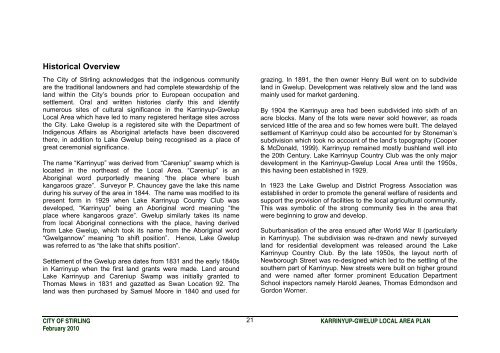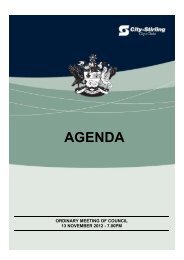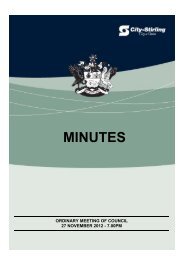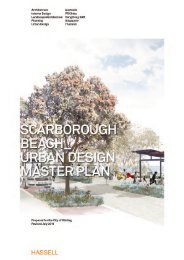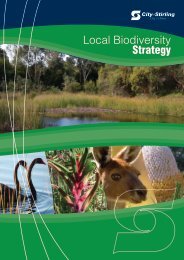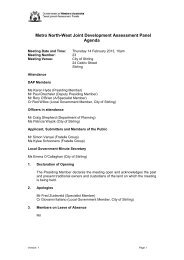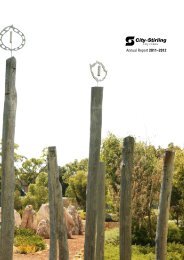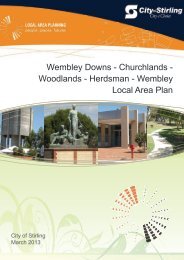KARRINYUP / GWELUP Local Area Plan - City of Stirling
KARRINYUP / GWELUP Local Area Plan - City of Stirling
KARRINYUP / GWELUP Local Area Plan - City of Stirling
Create successful ePaper yourself
Turn your PDF publications into a flip-book with our unique Google optimized e-Paper software.
Historical Overview<br />
The <strong>City</strong> <strong>of</strong> <strong>Stirling</strong> acknowledges that the indigenous community<br />
are the traditional landowners and had complete stewardship <strong>of</strong> the<br />
land within the <strong>City</strong>’s bounds prior to European occupation and<br />
settlement. Oral and written histories clarify this and identify<br />
numerous sites <strong>of</strong> cultural significance in the Karrinyup-Gwelup<br />
<strong>Local</strong> <strong>Area</strong> which have led to many registered heritage sites across<br />
the <strong>City</strong>. Lake Gwelup is a registered site with the Department <strong>of</strong><br />
Indigenous Affairs as Aboriginal artefacts have been discovered<br />
there, in addition to Lake Gwelup being recognised as a place <strong>of</strong><br />
great ceremonial significance.<br />
The name “Karrinyup” was derived from “Careniup” swamp which is<br />
located in the northeast <strong>of</strong> the <strong>Local</strong> <strong>Area</strong>. “Careniup” is an<br />
Aboriginal word purportedly meaning “the place where bush<br />
kangaroos graze”. Surveyor P. Chauncey gave the lake this name<br />
during his survey <strong>of</strong> the area in 1844. The name was modified to its<br />
present form in 1929 when Lake Karrinyup Country Club was<br />
developed, “Karrinyup” being an Aboriginal word meaning “the<br />
place where kangaroos graze”. Gwelup similarly takes its name<br />
from local Aboriginal connections with the place, having derived<br />
from Lake Gwelup, which took its name from the Aboriginal word<br />
“Gwelgannow” meaning “to shift position”. Hence, Lake Gwelup<br />
was referred to as “the lake that shifts position”.<br />
Settlement <strong>of</strong> the Gwelup area dates from 1831 and the early 1840s<br />
in Karrinyup when the first land grants were made. Land around<br />
Lake Karrinyup and Careniup Swamp was initially granted to<br />
Thomas Mews in 1831 and gazetted as Swan Location 92. The<br />
land was then purchased by Samuel Moore in 1840 and used for<br />
grazing. In 1891, the then owner Henry Bull went on to subdivide<br />
land in Gwelup. Development was relatively slow and the land was<br />
mainly used for market gardening.<br />
By 1904 the Karrinyup area had been subdivided into sixth <strong>of</strong> an<br />
acre blocks. Many <strong>of</strong> the lots were never sold however, as roads<br />
serviced little <strong>of</strong> the area and so few homes were built. The delayed<br />
settlement <strong>of</strong> Karrinyup could also be accounted for by Stoneman’s<br />
subdivision which took no account <strong>of</strong> the land’s topography (Cooper<br />
& McDonald, 1999). Karrinyup remained mostly bushland well into<br />
the 20th Century. Lake Karrinyup Country Club was the only major<br />
development in the Karrinyup-Gwelup <strong>Local</strong> <strong>Area</strong> until the 1950s,<br />
this having been established in 1929.<br />
In 1923 the Lake Gwelup and District Progress Association was<br />
established in order to promote the general welfare <strong>of</strong> residents and<br />
support the provision <strong>of</strong> facilities to the local agricultural community.<br />
This was symbolic <strong>of</strong> the strong community ties in the area that<br />
were beginning to grow and develop.<br />
Suburbanisation <strong>of</strong> the area ensued after World War II (particularly<br />
in Karrinyup). The subdivision was re-drawn and newly surveyed<br />
land for residential development was released around the Lake<br />
Karrinyup Country Club. By the late 1950s, the layout north <strong>of</strong><br />
Newborough Street was re-designed which led to the settling <strong>of</strong> the<br />
southern part <strong>of</strong> Karrinyup. New streets were built on higher ground<br />
and were named after former prominent Education Department<br />
School inspectors namely Harold Jeanes, Thomas Edmondson and<br />
Gordon Worner.<br />
CITY OF STIRLING 21<br />
<strong>KARRINYUP</strong>-<strong>GWELUP</strong> LOCAL AREA PLAN<br />
February 2010


